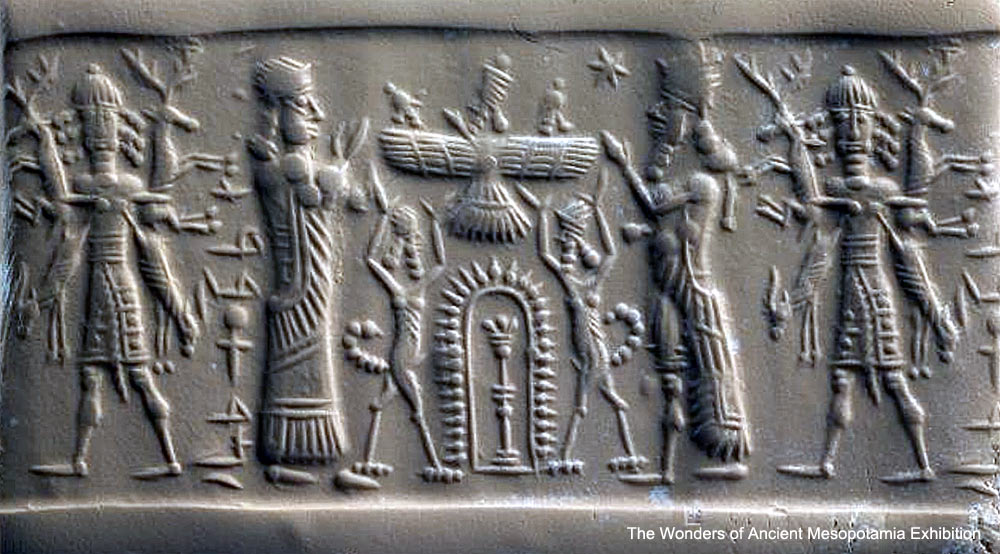
An Assyrian carnelian cylinder seal depicting a Worshipper on the left and a god on the right.
Are the seals today used as a source of artistic information? Thank you.
Asked by Sonia
Asko Parpola
There can be no doubt that some Indus seals are fine artistic achievements. Probably one of the main functions of the seal's iconographic motifs, and the quality of their carving, was to convey the status of the seal owner. There are some motifs, in particular the "contest" of a (royal) hero with two tigers (lions in Mesopotamia), that the Indus people adopted from West Asia.
Dennys Frenez
The artistic value of seals is secondary but undeniable. The combination of precious stones or metals and beautiful motifs finely carved often led to the production of actual artistic masterpieces. This is particularly true for those societies that exhibited the artistic quality and value of seals as symbol of the status of their owners, like in ancient Egypt, Mesopotamia, but also in Iran and Central Asia. By studying in high details the Indus seals and their impressions on clay, I am convinced that the significance and use of seals in the Indus Civilization was slightly different and their production was subject to strict rules dictated by a central authority that controlled also the mining and supplying of the high quality steatite used for manufacturing the seals and indicated the specific icon that had to brand the seal according to the role of its user within the hierarchical structure of this organization. This is the only explanation to the very high standardization of the Indus seals and its maintenance with very little variations for more than half a millennium.
The seal type used in the Indus Valley had no evident influence from the contemporaneous glyptic used in the Sumerian city states. The fact that in the Near East seals very introduced for administrative purpose already at the end of the Seventh millennium BCE does not automatically mean that they influenced directly all other seal productions in Middle Asia. In any case, we have to stop projecting the present-day social, economic, religious and political situations to the ancient societies. Cultural and political boundaries were different and worked differently. People travelled and ideas spread. Even if, hypothetically, the Harappans borrowed some ideas to the Sumerians they then re-elaborated them in a very original and unique way. Social and cultural evolution has not to be considered a race where communities from different regions competed for primacy, but the result of a collaboration, often unconscious, toward a better future for the mankind. Who cares about “the first one”? The winner is the one that eventually ensured a better life to his family and descendants.
Nisha Yadav
We do find some evidence of the influence of Sumerian seals on the seals of the Indus Valley civilization; see for example a few cylindrical seals with patterns engraved on them. Apart from the script, seals often include other components such as animal motifs, composite and multi-headed animals, feeding troughs, scenes as well as other intricate geometric and complex patterns (see for example: Yadav, N. and Vahia, M. N. 2011. Classification of Patterns on Indus Objects. International Journal of Dravidian Linguistics. vol. 40, pp. 89-114 and Vahia, M. N. and Yadav, N. 2010. Harappan Geometry and Symmetry: A Study of Geometrical Patterns on Indus Objects. Indian Journal of History of Science. vol. 45, pp. 343-368.
Sir Mortimer Wheeler has aptly described the Indus seals as: “At their best, it would be no exaggeration to describe them as little masterpieces of controlled realism, with a monumental strength in one sense out of all proportion to their size and in another entirely related to it.” (Sir Mortimer Wheeler, The Indus Civilization, 3rd Edition, 1968).
Mayank Vahia
The problem with Harappan seals is multi-fold. Most of them have standard structure of writing on the top and an animal motif with a feeding jar near its mouth. While some of these exquisitely done, they seem to be fundamentally different from several that look like pieces of art. It has been speculated that these were of ornamental use. They have no writing and the patterns are complex enough to challenge even modern artwork with its multiple circles and tiling designs. So they were certainly pieces of art my unsubstantiated opinion is that they were for ornamental use.
Image courtesy of Ancient Origins.
